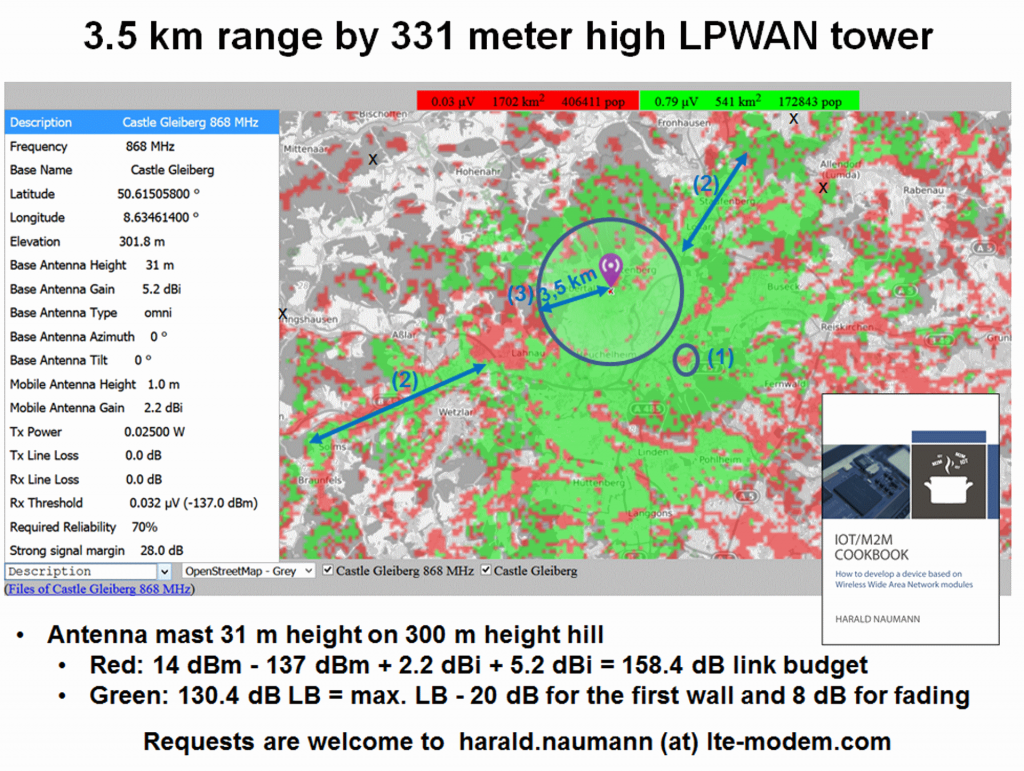Gleiberg Castle is situated on a 300 metre high mountain spur at the western end of the village of Gleiberg of the same-named. The castle structure consists of the rebuilt outer castle and the ruined core castle. The tower is 30 metres high and has a diameter of 11 metres. From the top of the tower there is a wide view of the region.
Because a good, experienced business partner operates his LoRaWAN gateway for test purposes in Gleiberg, it is logical to operate this gateway for test purposes on the 30 m high tower. No fixed installation is necessary for the test operation. An inexpensive LoRaWAN gateway with battery in a plastic housing is enough.
Key data for simulation and LPWAN test setup:
– Height of the gateway antenna = mountain height 300 m + keep 30 m + 1 m for the omnidirectional antenna = 331 meters
– Height of sensor antenna = 1 meter
– Sensor output power: 14 dBm
– Antenna gain sensor: 2.15 dBi
– Sensitivity Gateway: -137 dBm
– Antenna gain gateway: 5.15 dBi
– Sum of all profits and losses (link budget): 158.3 dB
Chosen losses in the LPWAN simulation:
– Margin, sum of the path loss through the first wall and fading: 28 dB
– Link budget minus loss in the wall and fading: 130.3 dB
On the green marked area you can identify the area with possible indoor supply. The red marked area shows the area where a supply outside the building is still possible. In the simulation, the many small red supply spots are caused by the hilly terrain in the region. The town of Giessen is covered in large parts but shows a red area southeast (1). This area cannot be completely covered from the Gleiberg site. Also of interest are the long-stretched green areas in the valley of the river Lahn (2). In the west the radio wave propagation is limited by a mountain range. The Königsstuhl mountain (3) with a height of 348 m plus the height of the trees of 5 m is higher than the antenna of our gateway. Behind the mountain the area is covered, because in the simulation we have enabled the calculation by refraction of radio waves. During the simulation, the software calculates the refraction of the radio wave at the mountain range and subtracts a static value from the link budget.
Summary of the LPWAN simulation:
From the gateway antenna to the mountain range with the mountain Königsstuhl the distance is about 3.5 km. The 15-45 km range of the repeating prayers mills is not visible in this simulation. The range of the gateway is limited in the west after 3.5 kilometers. In other directions it is partly 4-5 km. Similar effects can be seen in other regions in Germany. A range of 3.5 km including 28 dB loss for the first wall and fading is already a very good performance. When we want to achieve an overlap in the range of the gateways, the next gateway must not be more than 3.5 km away. At a distance of about 3.5 km we needed a location about 330 m high again. In most cases we realistically have to be happy with 25 m high locations on the roofs of houses.
Note:
Hopefully I was able to stimulate a few ideas with this short article. Anyone who is really planning a private LPWAN for their town or community is welcome to contact me for a radio network planning. We are happy to share the knowledge for such a planning in a workshop. Participants of the workshop only need basic knowledge in mathematics and should be familiar with the region for later planning. At the end of the workshop, our customer can perform the planning of the radio network himself. If required, the planning can be verified by our team.
Inquiries about workshops, consulting, development of LPWAN devices up to the development of customized, integrated antennas are welcome at harald.naumann(at)lte-modem.com.
